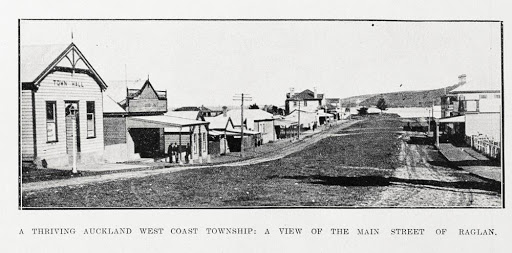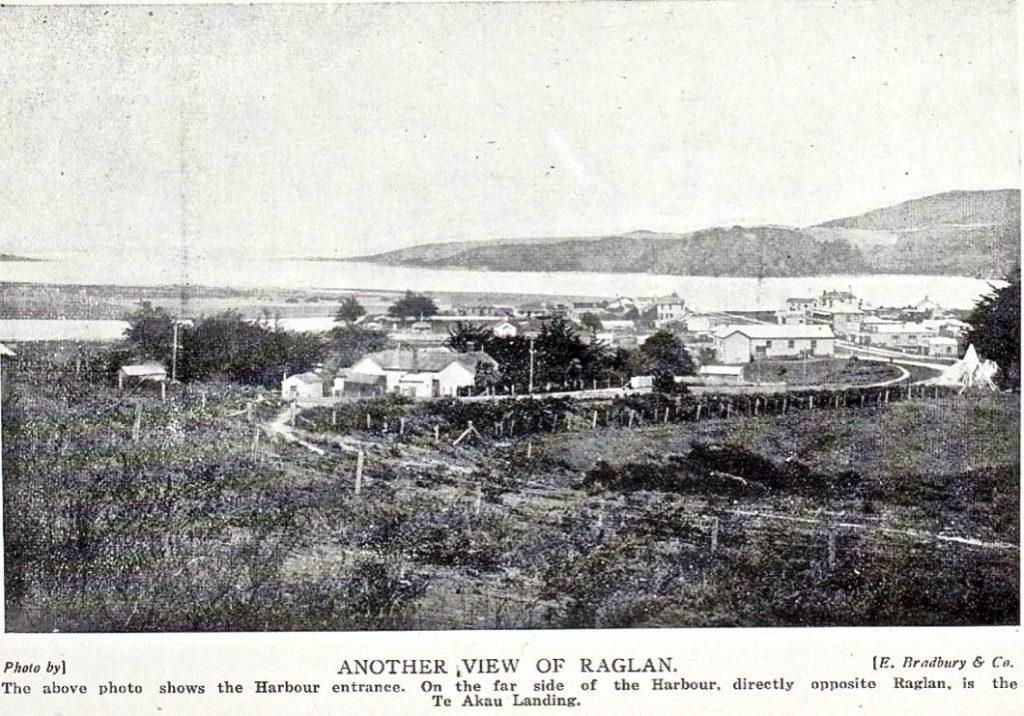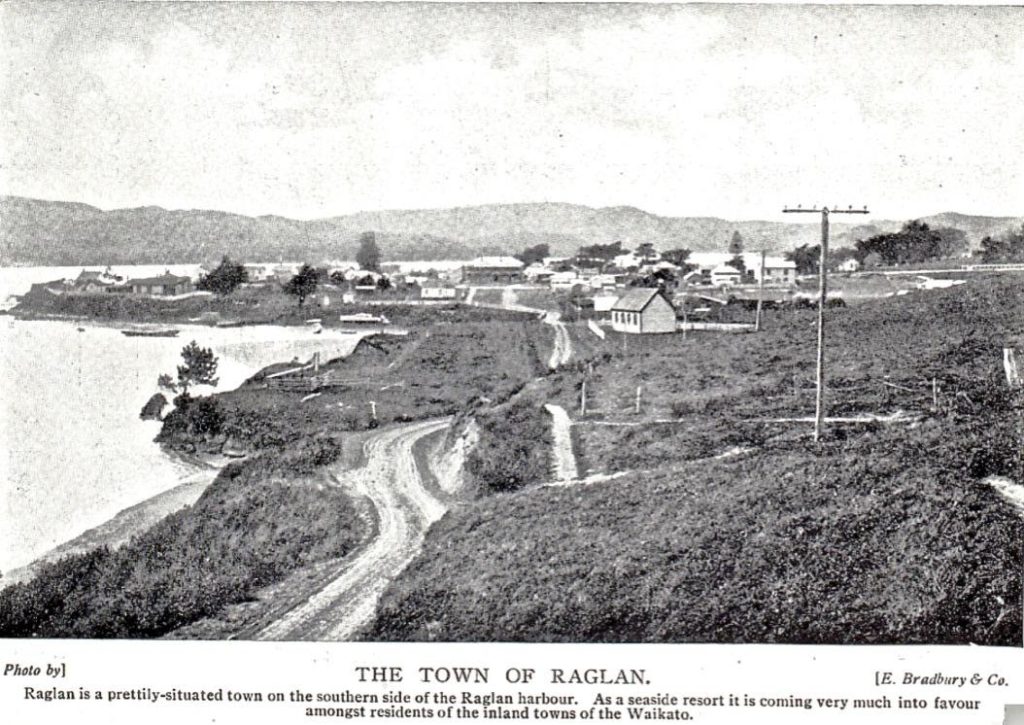By John Lawson
A century ago, the country was moving from post war shortages to 1920s recession. By June, wool was described as “unsaleable, the bottom knocked out of the stock market, and butter declining”. The government had borrowed £80m to fight the war. Keynesian economics was still unknown, so, when Reform Party Minister of Works (and later Prime Minister), Gordon Coates, visited Raglan in 1921, it was reported that, as national debt had risen to £200m, “He could not afford to build railways or electric works unless the service could be supplied to return a profit to the consumer. The present estimates were £300,000 a month, of which £100,000 was set aside for relief works. He had no intention of turning the public works of the country into relief works, as had been done in the past”.
Motor cars continued to take over from horses and another sea plane arrived, but Raglan still ran short of sugar and flour when storms held up ships, there were still reports of injuries due to horses bolting and saddler and harness maker, Frank Crawford, had a business in Bow St, next to Bernard’s Bakery (Show Off). As this photo published in 1921 shows, the wide grassy island in Bow St remained and there was no parking problem.

The muddy main road finally went into history when the wives of Councillor Rawlinson, the doctor and postmaster spread the last two feet of gravel at Kauroa on 27 April 1921. The decade-long project had cost over £20,000. The Waikato Times commented, “The next most important move is to get the harbour controlled by Raglan instead of Ngaruawahia.”
Other roads metalled in 1921 were Wallis St, Okete Rd, Te Mata Rd, Te Uku Landing Rd and Mangakino Rd. Council bought a new steamroller and a crushing plant was added at Gibbison’s quarry. Jerome’s Deviation Bridge, over Te Mata Stream, allowed the newer Te Mata Rd to take a more direct route than the previous bridge, aligned for the older route via Maungatawhiri Rd. Bankart St was formed in 1921, having been sold in 1917.
Improved roads were probably the reason for Raglan’s population more than doubling; from 154 in 1906 to 350 in 1931. They also started the decline of the port. In November 1921 a report said wool, previously shipped via Raglan, was trucked from Te Akau and Waingaro and railed from Ngāruawāhia. In 1920 the Waikato Times noted that, “never has the little township had so many visitors” and, of the 1921 season, it again said, “A record number of visitors took advantage of the glorious summer weather to visit Raglan for the annual carnival, and the once quiet little town was a scene of bustle and activity as the motor cars came pouring in, filling the garage and every available space.”
Travel across the harbour was made easier, with a telephone at the new Te Akau wharf replacing a bell as the means of calling the ferry-man. Also the “hours of the telephone exchange have been extended from 8 a.m. to 8 p.m.”
The Minister of Public Works’ visit Raglan in June related to a previous era. He formally opened the new wharf (in use from 1920) and turned the first sod for the War Memorial. Of the 75 who went to war from Karioi and Whaingaroa ridings, 21 had died. The cenotaph was described as an obelisk, surrounded by steps in a 15ft by 60ft reserve. It cost about £550, of which £294 had been collected by 1921. The rest was fundraised over the next two years. Warren and Blechynden, of Hamilton, built a 19 feet high Harcourt granite obelisk (from Mount Alexander near Melbourne), with a bronze sword near the top and a 2ft square polished plinth below, resting on a 7ft square granite pedestal. Earlier in the year, Richard Bollard, Raglan’s Reform Party M.P. from 1911 to 1927, opened Te Uku & District Memorial Hall. Later a new tennis court was built next to the Hall. It was also the year Waitetuna got new tennis courts.
The rugby club was another sport with its final home in 1921. The Waikato Times described the 6 acres as a ti-tree swamp, “slowly being reclaimed and laid out by efforts organised by the local Carnival club. . . The ladies of Raglan intend holding a “Paddy’s Market” on November 5, the proceeds to go to beautifying the newly-acquired recreation grounds. A fair amount of drainage will be necessary before the various sports can be satisfied.”
Another new sports ground was Raglan Bowling Club, which held its first meeting on 4 July 1921 and bought the first quarter acre of the current Club on 28 December 1921.
Walking was also popular. Raglan Chamber of Commerce received notice that the Tourist Department Minister would consider a grant for a track to the top of Karioi.
Indoor recreation also developed. The library of 1300 books, run by estate agent, A. R. Langley, was taken over by the Town Board and music also advanced in 1921; “An enthusiastic meeting was held in Raglan re formation of a brass band, when it was decided to form a town band It was also decided to vest the instruments in the Raglan Town Board. As there is already an Orchestral Society with a good string band, Raglan should be well provided with music for the future.”
There must have been a bit of a setback later in the year, when the shop of H. Salmon, Bow St bootmaker, but also bandmaster, caught fire. Farmers’ Trading Co (now Indi) was another shop with a problem. Its verandah was blown away in 1921.
Another 1921 incident was the Royal Hotel being charged with selling liquor on a Sunday to two occupants of a motor-car, which afterwards went over a bank on the deviation. The law was that liquor could be served with meals at a hotel, but not on Sundays to anyone other than boarders. The Sunday ban remained until 1999.
The photo below shows a navigation beacon on the far right. In 1921 the Ladies’ Church Guild raised over £200 towards the building the new Church of St. Peter, which replaced the beacon in 1924.

Bryant home (now Bible Camp) also had its origin in 1921. On 21 October Dan Bryant started the process of setting up a children’s convalescent home on 73 acres of his bush and farm.
1921 marked the end of the flax industry. The combination of low returns in the 1921 recession, and the rapid spread of the yellow leaf disease, reduced production to 9,643 tons, after which the industry in Raglan never recovered.
An enterprise which seemed likely to proceed was the Frankton to Raglan 2ft. 6in. gauge railway, via the Waitetuna Valley, which was estimated to, “be operating in two and a-half years. . . a tender has been received from an Australian firm, the price, which includes rolling stock, being £300,000. . . trains will be able to make a speed of from 10 to 14 miles an hour.” Like other light railways, but not most roads, it needed ratepayer support, which it failed to gain.
Lastly, another photo published in 1921. Some buildings from a century ago remain, but Wainui Rd was a winding track and Raglan was still small. A bridge remained over the creek near Stewart St. Sawmills operated on Karioi and often the atmosphere was filled with the smoke of bush fires. Change was slow, but happening.



This is a really interesting series of articles, good work putting these out.
Fantastically interesting thanX John and i luv the old pics